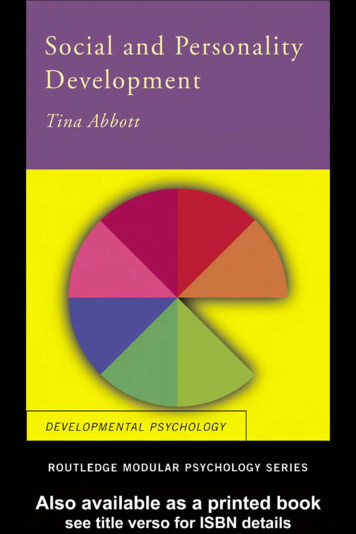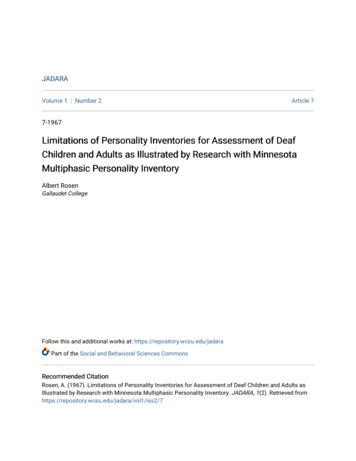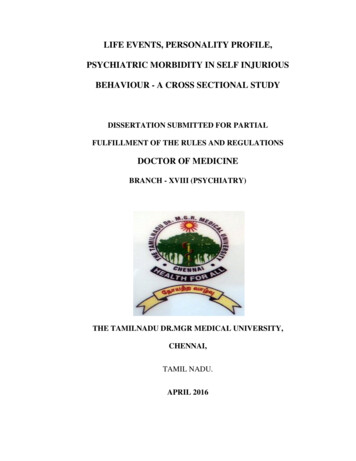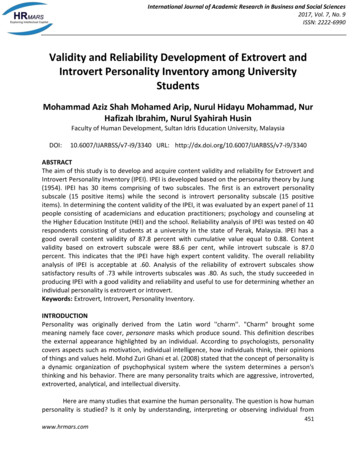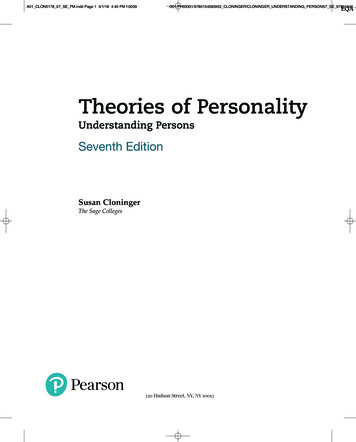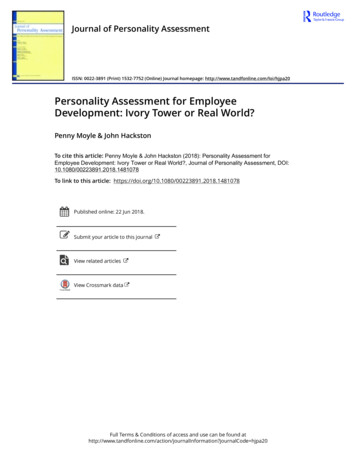
Transcription
Journal of Personality AssessmentISSN: 0022-3891 (Print) 1532-7752 (Online) Journal homepage: http://www.tandfonline.com/loi/hjpa20Personality Assessment for EmployeeDevelopment: Ivory Tower or Real World?Penny Moyle & John HackstonTo cite this article: Penny Moyle & John Hackston (2018): Personality Assessment forEmployee Development: Ivory Tower or Real World?, Journal of Personality Assessment, DOI:10.1080/00223891.2018.1481078To link to this article: shed online: 22 Jun 2018.Submit your article to this journalView related articlesView Crossmark dataFull Terms & Conditions of access and use can be found tion?journalCode hjpa20
JOURNAL OF PERSONALITY 81078SPECIAL SECTION: ORGANIZATIONAL AND CONSULTING PSYCHOLOGYPersonality Assessment for Employee Development: Ivory Tower or Real World?Penny Moyle1 and John Hackston21Meyler Campbell, Oxford, UK; 2OPP Ltd., Oxford, UKABSTRACTARTICLE HISTORYThe acceptance and popularity of personality assessments in organizational contexts has grownenormously over the last 40 years. Although these are used across many applications, such as executivecoaching, team building, and hiring and promotion decisions, the focus of most published research on theuse of personality assessments at work is biased toward assessment for employee selection. Reviews havetherefore tended to use criteria that are appropriate for selection, neglecting the additional and differentcriteria that are important in relation to employee development. An illustration of the often-discussedscientist–practitioner divide is that the Myers–Briggs Type Indicator is the most widely known and usedpersonality assessment in organizations, despite harsh criticism by the academic community. This articlereviews this debate, and draws implications for the appropriate choice of personality assessments for usein individual and team development, and a new direction for scientific research.Received 31 August 2017Revised 1 May 2018Personality inventories originated in clinical psychology, evolving from highly specific assessments such as the WoodworthPersonal Data Sheet (Woodworth, 1917) and the PersonalitySchedule (Thurstone, 1930) through to multidimensionalinstruments such as the Bernreuter Personality Inventory (BPI;Bernreuter, 1931) and the Minnesota Multiphasic PersonalityInventory (MMPI; Hathaway & McKinley, 1943). In the mid20th century, personality questionnaires were developed formore general use. Some, such as the Sixteen Personality Factorquestionnaire (16PF; Cattell, 1946; Cattell, Cattell, & Cattell,1993) and the NEO PI (Costa & McCrae, 1985) were constructed on an empirical basis. Others were built on theoreticalfoundations and clinical experience. The Myers–Briggs TypeIndicator (MBTI; Myers, 1962; Myers, McCaulley, Quenk, &Hammer, 1998) was based on the work of Jung (1971).As defined by Jacobs and Washington (2003), “Employeedevelopment refers to an integrated set of planned programs,provided over a period of time, to help assure that all individuals have the competence necessary to perform to their fullestpotential in support of the organization’s goals” (p. 344).Although personality assessments have featured in employeedevelopment for nearly a century, their use over the last 15 yearshas grown significantly (McDowall & Redman, 2017). Personality-based development is now commonplace at all levels oflarge organizations, and many smaller ones (Passmore, 2012).Examples include team building, executive coaching, leadershipdevelopment, communication, and resilience training.Human resources (HR) practitioners and managers havehundreds of personality tests available to them, many reviewedby respected bodies such as the Buros Center for Testing or theBritish Psychological Society (BPS). Furnham (2008a) reportedthat the top ranked assessments used by UK HR practitionersCONTACT Penny Moyle 2018 Taylor & Francispennymoyle@hotmail.comfor development were the MBTI, Fundamental InterpersonalRelationship Orientation (FIRO), 16PF, assessments based onthe Big Five model of personality, and the Belbin Team RoleSelf-Perception Inventory, with the most popular being theMBTI, used by over half the group. This overlapped, but contrasted with, the most popular assessments for selection: BigFive assessments, 16PF, Occupational Personality Questionnaire (OPQ), Hogan Personality Inventory (HPI), and PersonalProfile Analysis (PPA).Academic reviews tend to be highly critical of several assessments popular in the development arena (e.g., Chamorro-Premuzic, Winsborough, Sherman, & Hogan, 2016; Furnham,2008a). Chamorro-Premuzic et al. (2016) are typical, in notingthat “there is a substantial gap between what science prescribesand what HR practitioners do, especially around assessmentpractices” (p. 635). The MBTI attracts particularly severe criticism (e.g., Carter, 2016; Essig, 2014; Grant, 2013; McCrae &Costa, 1989; Michael, 2003; Murphy Paul, 2004; Pittenger,2005), with views about its continued popularity ranging fromconcern to consternation and disbelief.Although less published literature is available on the manyother assessments used in employee development, manycriticisms leveled at the MBTI also apply to these. For example,the FIRO–B (reviewed by Furnham, 1990, 2008b) and BelbinTeam Role Self-Perception Inventory (reviewed by Furnham,Steele, & Pendleton, 1993) are both criticized for poor constructand predictive validity, and poor reliability. Other Jungianbased type indicators, similar to the MBTI, are criticized lessoften, although they share many of the same features. Examplesinclude the Enneagram (Wagner, 1983), Golden PersonalityType Profiler (Golden, 2004), Insights Discovery (Lothian,1996) and Lumina Spark (Desson, 2017). Strengths inventories,Highview, Vernon Ave., Oxford, OX2 9AU, UK.
2MOYLE AND HACKSTONmultirater or 360 feedback instruments, and emotional intelligence (EI) assessments are increasingly popular in organizations, but have also been criticized (e.g., McDowall & Redman,2017, on strengths inventories; Fletcher, Baldry, & Cunningham-Snell, 1998, on 360 assessments; Conte, 2005, on EImeasures).In this article we examine the popularity of the MBTI,together with the common criticisms of it. This example provides new perspectives on the scientist–practitioner divide inchoosing personality assessments for employee development.Overview of the MBTI assessmentThe MBTI (Myers et al., 1998) was developed to make Jung’stheory of personality types “understandable and useful in people’s lives” (p. 3). In doing so, Myers and Briggs included theirown interpretation and extension of Jung’s original theory. Thestandard version (MBTI Step I) sorts individuals according tofour dichotomies, as defined in Table 1, which are then combined to create 16 categorical types. There also exists a moreelaborate version of the assessment, MBTI Step II, which breaksdown each dichotomy into five behavioral facets, each measured on an 11-point scale (Quenk, Hammer, & Majors, 2004).Although MBTI Step II is also widely used and addresses someof the criticisms leveled at the standard assessment, it is lesswell-known and has attracted little comment in the scientificliterature. Furnham (2017) noted that the MBTI is the mostwidely known and used personality assessment in the world,taken by anywhere from 1.5 million to 5 million people everyTable 1. The four dichotomies of the Myers–Briggs Type Indicator assessment.Extraversion–Introversion dichotomy(attitudes or orientations of energy)Extraversion (E)Key criticisms of the MBTIDespite, or perhaps because of its popularity, the MBTI hasbeen the subject of considerable criticism, both in the academicliterature (e.g., Chamorro-Premuzic et al., 2016; Furnham,1990, 2017; Furnham & Crump, 2014; McCrae & Costa, 1989;Michael, 2003; Pittenger, 2005) and by popular psychologyauthors (e.g., Carter, 2016; Essig, 2014; Grant, 2013; MurphyPaul, 2004). Whereas some criticisms are backed by scientificanalysis and reasoned argument, others are opinion pieces withlittle substance behind them. For example, Essig (2014) wroteabout the “mystery” of the MBTI’s popularity, asserting, “[T]heMBTI is pretty much nonsense, sciencey snake oil. As is wellestablished by research, it has no more reliability and validitythan a good Tarot card reading.” Chamorro-Premuzic et al.(2016) stated, “In a world driven by accuracy, the Myers–Briggswould not be the most popular assessment tool” (p. 635).Carter (2016) ended with a rallying cry of, “The fight againstthe MBTI will continue” (p. 30). The most common criticismsare summarized and addressed next.Introversion (I)Directing energy mainly toward theouter world of people and objectsDirecting energy mainly toward theinner world of experiences andideasSensing–Intuition dichotomy(functions or processes of perception)Sensing (S)Intuition (N)Focusing mainly on what can beperceived by the five sensesFocusing mainly on perceivingpatterns and relationshipsThinking–Feeling dichotomy(functions or processes of judging)Thinking (T)Feeling (J)Basing conclusions on logical analysiswith a focus on objectivity anddetachmentBasing conclusions on personal orsocial values with a focus onunderstanding and harmonyJudging–Perceiving dichotomy(attitudes or orientations toward dealing with the outside world)Judging (J)Preferring the decisiveness and closurethat result from dealing with theouter world using one of thejudging preferences(thinking or feeling)year. A 2014 Forbes article reported that the MBTI is in use by89 of the Fortune Top 100 (Essig, 2014).The MBTI manuals (Myers et al., 1998; Quenk et al., 2004)document extensive research, including its adaptation and validation in more than 20 languages and cultures, and are regularly supplemented by new research from the test publisher(e.g., Hackston, 2015; Hackston & Dost, 2016; OPP, 2013,2016). Additional research supporting its use is reported andreviewed elsewhere (e.g., Bayne, 1995; Carlyn, 1977; Hammer& Huszczo 1996; McCaulley, 2000), particularly in the Journalof Psychological Type (JPT), a peer-reviewed journal, publishedsince 1977, which focuses on research relating to Jungian personality types.Perceiving (P)Preferring the flexibility andspontaneity that results fromdealing with the outer world usingone of the perceiving processes(sensing or intuition)Note. Taken with permission from Myers et al. (1998).Trait not typeCritics argue that personality is best described by continuous,normally distributed traits, rather than by discontinuous types(Barbuto, 1997; Furnham, 2017; Pittenger, 2005). The MBTIStep I, in contrast, is designed to sort individuals into one of 16categories. Several critics of the MBTI state that this categorization does not capture the full range of personality variance andreduces predictive power (e.g., Barbuto, 1997; Grant, 2013),describing type concepts as “out of date” (Furnham, 2017) andas a “misrepresentation of the available evidence” (Pittenger,2005). Whereas the conceptualization of personality variablesas equal-interval continuous or integer-valued quantities(traits) is the mainstream view of academic psychometricians,measurement theorists dispute this stance (Michel, 2000, 2012;Tafreshi, Slaney, & Neufeld, 2016), with Michel characterizingit as “methodologically thought disordered” and “pathologicalscience.”In any case, MBTI and Jungian theory have never suggestedthat anyone limits behavior to just one side of a dichotomy. Onthe contrary, the theory posits that we all use both sides, butwith a preference for one side over the other, just as we have apreference to write either with our right or left hand, but wecan develop skill in using both hands. For example, everyone
PERSONALITY ASSESSMENT FOR EMPLOYEE DEVELOPMENTneeds to act in the external world (extraversion) but also needstime for reflection (introversion). The MBTI Step I questionnaire sets out to capture an individual’s underlying preference,but their behavior will also relate to their current situation andpast environmental influences. In MBTI theory, we can choosewhether to act in an extraverted or an introverted way,although one will be easier, and require less energy (Myers &Myers, 1995).Dividing personalities into just 16 types is of course, a simplification of human nature. If the goal is to capture maximalvariance and to predict behavior from the scores alone, thenthe MBTI is not the right assessment to use. It does, however,provide simple labels and useful rules of thumb to help peopleunderstand individual differences, without overwhelming themwith too much information. For those who wish to go further,MBTI Step II captures more of the continuously distributedbehavioral differences between people, or a trait tool such asthe NEO PI or 16PF can be of benefit. Even critics such as Pittenger (2005) concede that “type-as-a-label” has great utilityfor this introductory stage of personnel development. Issues ofpoor practice arise when MBTI Step I scores are erroneouslyinterpreted as if they measure behavior, rather than an indication of categorical preference.A linked criticism is that if the MBTI dimensions were trulydichotomous, then MBTI continuous scores should have abimodal distribution, but do not (Arnau, Green, Rosen,Gleaves, & Melancon, 2003; Girelli & Stake, 1993). However,other studies have shown that when item-response theorymethods are used to score the MBTI (as with the current FormM version), scores are indeed bimodal (e.g., Harvey & Murray,1994). In any event, this focus might somewhat miss the point,given the utility of simple categories to facilitate layunderstanding.Test–retest reliabilityCritics assert that the MBTI has poor test–retest reliability. Forexample, Pittenger (2005) noted that a high percentage of people change at least one dichotomy when they take the MBTIquestionnaire a second time. However, in looking to replicatethe same four-letter type (i.e., all four dimensions simultaneously), such critics are holding the MBTI to a higher level ofrepeatability than is used for trait measures, which only everreport reliability one scale at a time. Each of the MBTI dimensions shows excellent stability; for example, the U.S. Form M ofthe MBTI shows test–retest correlations of between .83 and .97over a 4-week interval, higher than that of many establishedtrait measures, and over intervals greater than 9 months MBTIForm G also showed good stability (.77–.84). Moreover, thereis agreement of 84% to 96% for each dichotomy over 4 weeks,with a median of 90% (Myers et al., 1998). The chance of coming out the same type on all four scales would therefore be0.904, or 66%, which is very close to the observed 65% in fieldresearch, with 93% of respondents maintaining the same fourletter type, or changing just one dimension (Myers et al., 1998,p. 164).Salter, Forney, and Evans (2005) noted that MBTI test–retest reliability studies have had mixed results, in part dueto “unsophisticated analytical strategies.” In their own3analysis, they concluded, “if the goal of using the MBTIinstrument is to help individuals to become aware of their‘true type’ dispositions, which should remain relatively stable over time, then our results seem consistent with thatobjective” (p. 217). A meta-analytic study of the MBTI byCapraro and Capraro (2002) found strong internal consistency and test–retest reliability. Across all dimensions,median internal consistency reliability was 0.816 (from 50coefficients) and median test–retest reliability was 0.813(from 20 coefficients). The lowest reliability was 0.480, onthe T-F dimension, from a test–retest study of 17 men; thehighest was 0.97, on the S–N, T–F, and J–P dimensions,from a sample of 343 senior managers.Predictive validityPittenger (2005) noted that there is a “conspicuous lack of datademonstrating the incremental validity of the MBTI over othermeasures of personality” (p. 218). Boyle (1995), Furnham(2017), Grant (2013), and McCrae and Costa (1989) made similar critiques. These criticisms appear to derive from three misconceptions: first, that the purpose of the MBTI is similar tothat of personality assessments used for employee selection(predicting job performance); second, that because such information is lacking, the MBTI does not therefore possess any criterion-related validity; and third, that any validity the MBTIdoes possess does not show any incremental validity over thatof other personality instruments. All three assertions are illfounded.A central tenet of MBTI theory is that individuals canchoose to act against type (or “flex”), if the occasion demandsit, and over time they might become very proficient at acting ina nonpreferred way (Myers & Myers, 1995). It is therefore notsurprising that an individual’s four-letter type preferencesmight not relate to job performance. The validity of the MBTIhas, however, been demonstrated in a range of relevant contexts. Examples include the following. Homogeneity within organizations, as predicted bySchneider’s (1987) Attraction–Selection–Attrition (ASA)theory (Quintero, Segal, King, & Black, 2009; Thomas,Benne, Marr, Thomas, & Hume, 2000; Wallick, Cambre,& McClugage, 2000). Career search (Tinsley, Tinsley, & Rushing, 2002). Dealing with conflict (Insko et al., 2001; Kilmann &Thomas, 1975; Mills, Robey, & Smith, 1985). Decision making (Gallen, 2006; Haley & Stumpf, 1989;Hough & Ogilvie, 2005). Interplay of occupational and organizational membership(Bradley-Geist & Landis, 2012). Health, well-being, coping, and stress (Allread & Marras,2006; Buckworth, Granello, & Belmore, 2002; Du Toit,Coetzee, & Visser, 2005; Horacek & Betts, 1998; Short &Grasha, 1995). Relationship with occupational interests (Briggs, Copeland, & Haynes, 2007; Fleenor, 1997; Garden, 1997). Ratings of transformational leadership (Brown & Reilly,2009; Hautala, 2005, 2006; Sundstrom & Busby, 1997). Use of technology, e-mail, and social media (BishopClark, Dietz-Uhler, & Fisher, 2006–2007; Bowen,
4MOYLE AND HACKSTONFerguson, Lehmann, & Rohde, 2003; Goby, 2006; Hackston & Dost, 2016; Weber, Schaubhut, & Thompson,2011). Working in teams (Amato & Amato, 2005; Choi, Deek, &Im, 2008; Glaman, Jones, & Rozelle, 1996; Hammer &Huszczo, 1996; Schullery & Schullery, 2006).Whereas the Five-Factor Model (FFM) demonstrates incremental validity over the MBTI in predicting job performance(e.g., Furnham, Jensen, & Crump, 2008), the MBTI has shownincremental validity over trait questionnaires in other situations.For example, Edwards, Lanning, and Hooke (2002) confirmedthe incremental validity of the MBTI instrument over the NEOPI–R in predicting attributional adjustment, with no significanteffects relating to the NEO. The interaction effect of JudgingPerceiving Sensing-Intuition Impressions was significant, t(265) D 2.45, b D 0.124, p .026 (see Table 1 for definitions ofJudging-Perceiving and Sensing-Intuition dimensions). Pulverand Kelly (2008) showed that the MBTI assessment addedpredictive power to the Strong Interest Inventory assessment instudents’ selection of study majors, improving correct classifications in a discriminant analysis by 3%. A study by Renner, Bendele, Alexandrovicz, and Deakin (2014) used confirmatory factoranalysis to demonstrate that the MBTI adds unique explanatoryvariance over and above the NEO Five-Factor Inventory. In theirstudy, a model that assumed two distinct but correlated factorsfor each of the NEO–MBTI matched scales (Comparative FitIndices [CFIs] of 0.720–0.824) described the data better thaneither a model assuming two orthogonal factors (CFIs of 0.653–0.753) or a single factor (0.652–0.758).For a psychometric tool used in development, arguably themost important aspect of predictive validity is whether it hasdemonstrated effective outcomes (Rogers, 2017; Scoular, 2011).The effectiveness of MBTI-based interventions has been shownin many contexts. For example, McPeek et al. (2013) showedpositive effects on student grades following MBTI-based trainingwith teachers (Cohen’s d D 0.16). Katz, Joyner, and Seaman(1999) found that community college students were as likely tochange career goals following MBTI feedback as they were following interest inventory feedback, and more likely to changefollowing joint feedback, x2(3, N D 427) D 10.64, p D .01. Leong,Hardin, and Gaylor (2005) found that medical students reportedmore certainty in career choice after an MBTI-based workshopthan before, F(1, 107) D 11.71, p D .001, Cohen’s d D 0.29.Stockill (2014) reported improved ratings of teamwork after anMBTI-based intervention (Cohen’s d D 0.50). Positive effects ofMBTI-based interventions have also been reported in relation toimproving communication (Ang, 2002), improving problemsolving style in teams (Sedlock, 2005), and designing residentialenvironments (Schroeder, Warner, & Malone, 1980).Factor structure and the absence of neuroticismMcCrae and Costa (1989) reported correlations between theMBTI and the NEO PI separately for men and women. Correlations were consistently in the expected direction: E-I and Extraversion (r D .74 for men; r D .69 for women), S-N andOpenness to Experience (r D .72 for men; r D .69 for women),T-F and Agreeableness (r D .44 for men; r D .46 for women)and J-P and Conscientiousness (r D .49 for men; r D .46 forwomen). Similar results have been found by others with boththe NEO and 16PF (Furnham, 1996; Furnham, Moutafi, &Crump, 2003; OPP, 2016; Russell & Karol, 1994).One interpretation of these findings is that this is a demonstration of construct validity; these four factors emerge fromJung’s observations, Myers and Briggs’s assessment, and theempirical approach of the NEO and 16PF. However, many critics prefer to highlight that the MBTI is missing an importantfactor, neuroticism (e.g., McCrae & Costa, 1989; Furnham,2018). Some go so far as to use this finding as evidence that theMBTI is subsumed by the FFM and therefore redundant (Pittenger, 2005), even though the incremental validity researchmentioned earlier contradicts this.The absence of a measure of neuroticism is a spurious criticism. Although the MBTI framework does include consideration of stress and anxiety (Quenk, 1998, 2002), there is noclaim that the questionnaire itself measures this factor of personality, nor that questionnaire results will enable predictionsabout individuals that relate to state or trait anxiety. Instead, adeliberate decision was made in the assessment’s constructionnot to add in this fifth factor to the assessment, so as to keepfocus on the positive and productive differences between people(Myers et al., 1998), an approach that has become a core tenetof the strengths movement (e.g., Peterson & Seligman, 2004).There is no necessary virtue in an assessment providing fullcoverage of every aspect of personality. For example, a recentreview of predictors of job performance (Schmidt, Oh, &Shaffer, 2016) concluded that only one of the Big Five dimensions (Conscientiousness) consistently provides incrementalpredictive power. For employee development, many practitioners judge that the positive language associated with theMBTI, and the absence of neuroticism, is of much greateradvantage than using a more comprehensive measure; theMBTI is therefore often favored as the first personality assessment to be introduced. Once the ice is broken and where timepermits, additional personality measures can be used; thesemight well include a trait measure of anxiety (Passmore, 2012;Rogers, 2017; Scoular, 2011).The factor structure and construct validity of the MBTI havealso been criticized. For example, Sipps, Alexander, and Freidt(1985) found a six-factor solution, and Saggino and Kline(1996) found that the factor structure of the Italian researchversion did not fit the MBTI model. However, other studieshave supported the four-factor structure. Saggino, Cooper, andKline (2001) found that the models that best fit the data werethe four-factor model (CFI D 0.621) and a five-factor modelconsisting of the four MBTI dimensions plus an additional factor (CFI D 0.750). Harvey, Murry, and Stamoulis (1995) founda four-factor solution, with goodness-of-fit indexes (GFIs) foroblique models ranging from .744 to .900, as did Bess, Harvey,and Swartz (2003; GFI D 0.854) and Thompson and Borello(1989; GFI D 0.78). Although none of the latter three studiesexceeded a GFI of 0.90, all found that a four-factor solutionwas the best fit to the data.FakeabilityAll self-report personality questionnaires are reliant on somedegree of self-awareness and honesty. The MBTI is often
PERSONALITY ASSESSMENT FOR EMPLOYEE DEVELOPMENTcriticized for being highly fakeable (Carter, 2016; Furnham,1990), and research has demonstrated that in Western culturesand organizations, there is a degree of social pressure to conform to extraverted, sensing, thinking, and judging preferences,as defined in Table 1 (Kendall, 1998). However, while demonstrating that faking can happen, Furnham (1990) also notedthat subjects found the MBTI questionnaire difficult to fake,and concluded that if faking occurs, it is not particularly easy todo.Fakeability is critical when questionnaires are being used forhigh-stakes assessment, such as to determine future opportunity. Used correctly in a developmental context, there shouldbe no pressure to fake a particular profile, as the primary audience for the results is the individual themselves. Moreover,unlike traditional trait-based questionnaires, the MBTI processdoes not take the questionnaire results as the final categorization. It is intended to be used as an indicator of an individual’spreference. Questionnaire data are one component of feedbackwith a trained practitioner in exploring what might be an individual’s best fit type. During this process, any cultural, socialdesirability, or other pressures to be of a certain personalitytype (or to fake the questionnaire results) can be explicitly discussed and resolved. Therefore, fakeability is not a major concern for MBTI use.Barnum effectsMBTI interpretation and reports have been criticized as usingthe Barnum effect, where the descriptions of individuals seeminsightful but would in fact apply to anyone. For example,Pittenger (1993) stated, “The descriptions of each type are generally flattering and sufficiently vague so that most people willaccept the statements as true of themselves” (p. 486). However,Carskadon and Cook (1982) refuted the idea that type descriptions other than one’s own might be equally appealing. Individuals were shown four type descriptions and asked to rank orderthem in terms of their accuracy. Chi-square analysis showed thatthe distribution of ranks was nonrandom, x2(3) D 48.98, p .001, and that a far greater than expected proportion of subjectsranked their assessed description as number one compared to allother descriptions combined, x2(11) D 59.0, p .001.Applying evidence-based practice: The scientist–practitioner divideMuch has been written about the scientist–practitioner dividein occupational and organizational psychology (e.g., Andersen,Herriot, & Hodgkinson, 2001; Gray, Iles, & Watson, 2010).Andersen et al. (2001) are typical in notingPractitioners and researchers have often held stereotypical views ofeach other, with practitioners viewing researchers as interested only inmethodological rigor whilst failing to concern themselves with anything in the real world, and researchers damning practitioners forembracing the latest fads, regardless of theory or evidence. (p. 392)Such debates are generally accompanied by a call for greaterevidence-based practice (e.g., Barends, Rousseau, & Briner,2014; Gifford, 2016), urging more attention to the scientific literature, so as to take advantage of the best available evidence in5designing and delivering successful interventions. We agreewholeheartedly with this intent. Barends et al. (2014) recommended that four different kinds of evidence should be considered: scientific, organizational, evidence from practitioners(professional judgment, tacit knowledge), and stakeholder evidence (from people affected by the decision).Academics and researchers frequently give precedence toscientific evidence, defined by Barends et al. as findings “fromempirical studies published in academic journals.” Employeeselection is an example where science and practice have successfully combined (Barends et al., 2014; Gifford, 2016), with asubstantial, well-reviewed, and consolidated body of literaturefrom which practitioners can identify relevant research (e.g.,Robertson & Smith, 2001; Schmidt et al., 2016; Schmidt &Hunter, 1998). Unfortunately many writers extrapolate to arguethat assessments valid for selection are therefore the mostappropriate for all organizational applications, as they mistakenly believe that the value of a personality assessment is alwaysits ability to afford useful predictions of work performance(e.g., Barrick & Mount, 2005; Chamorro-Premuzic et al., 2016;Pittenger, 2005). This is not the case when it comes to employeedevelopment.When practitioners choose a personality assessment by considering organizational factors and subjective experiences, wecontend that, rather than them ignoring the scientific evidence,they are in fact taking advantage of the best available evidence.Personal, peer, and colleagues’ experiences, rather than beingthe irrelevant noise of the “latest fads” (Andersen et al., 2001),are actually important and valuable data in choosing an assessment, and might also be the only data available that takes thespecific organizational context into account.It is recognized that practitioners choose different personality assessments for use in development versus selection(Furnham, 2008a; Furnham & Jackson, 2011). However, whenresearchers ask practitioners, “How valid do you rate this test?”(e.g., Furnham, 2008a), many distinct forms of validity andapplications are confounded, with conclusions
of the criticisms leveled at the standard assessment, it is less well-known and has attracted little comment in the scientific literature. Furnham (2017) noted that the MBTI is the most widely known and used personality assessment in the world, taken by anywhere from 1.5 million to 5 million people every year.


